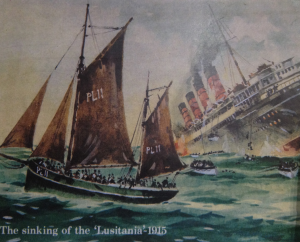 As part of the 100 year anniversary commemorations of the 1st world war on the Isle of Man the Peel Town Commissioners have decided to mark the centenary of the sinking of the Cunard Line passenger liner ‘Lusitania’ by the U boat U20 off the Irish coast on 7 May 1915.
As part of the 100 year anniversary commemorations of the 1st world war on the Isle of Man the Peel Town Commissioners have decided to mark the centenary of the sinking of the Cunard Line passenger liner ‘Lusitania’ by the U boat U20 off the Irish coast on 7 May 1915.
The Wanderer (PL11) a Peel built and operated fishing boat was the first on the scene of the disaster as she had been shooting her nets 10 miles south of Kinsale head when the Lusitania was torpedoed. She sailed to the scene and was able to pick up over 160 survivors. Luckily the sea was calm and they took 110 on board and towed the others in a raft and lifeboat until they could be transferred to other boats. The letters from the crew of the Wanderer provide a vivid first hand account of the final moments of the Lusitania and the efforts to rescue as many as they could in a small fishing boat which quickly became overloaded. See http://www.isle-of-man.com/manxnotebook/mannin/v6p315.htm
The owner of Wanderer in 1915 was Charles Morrison, a Peel grocer. His daughter Eleanor Morrison was married to William Edward Teare, sailmaker and partner in Teare and Sons ships chandlers.
There were 128 American citizens amongst the dead and in firing on a non military ship without warning the Germans had breached international law (the Cruiser Rules). The Germans had reason for treating Lusitania as a naval vessel because she was reportedly carrying munitions and the British had been breaching the Cruiser Rules but this sinking caused a storm of protest in the United States and the resulting propaganda was important in changing public opinion and the subsequent decision for America to enter the war.
See the recent BBC article and video at http://www.bbc.co.uk/news/world-europe-isle-of-man-28677593
For more information on the Lusitania Commemorations in Peel on Sunday 3 May 2015 see www.the wanderer100.com
